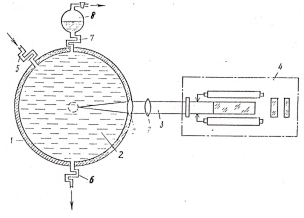Quantity comparison of disinfection methods
Comparing the cost of various methods of sewage treatment is a difficult task, especially when comparing costs in different countries, taking into account population density, level of industrialization and specialization of agricultural imports and exports, output growth, low or high levels of purification, the requirements of existing regulations and laws.
To compare the actual value of the various methods must also take into account capital and operating costs within the overall annual costs. Only if the above principal factors affecting the different types of expenses are taken into account quantitatively, the value of the comparison will be fair and may lead to useful results in practice.
The task is further complicated if you want to compare the existing methods with a relatively new technology and the future possibilities of implementing the various ideas of inventors.
At the stage of peer review, obviously, at least, for comparison of energy consumption of different methods to operate on unit costs of energy for the decontamination of one cubic meter of wastewater.
Below is a comparative table of unit energy consumption of different electro-physical (energy-consuming) methods of disinfection and a short description of each method, with the summary diagrams and/or drawings.
The data for boiling and alternative powered-consumption methods of disinfection of waste waters
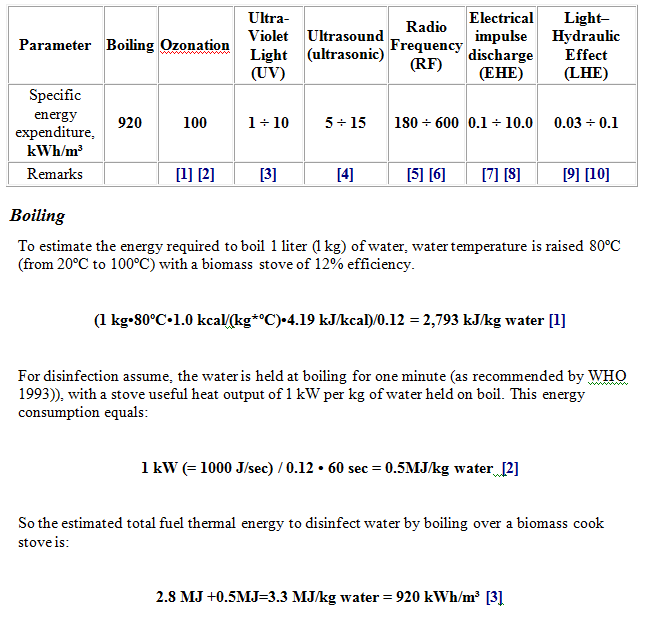
Ozonation
Ozonation equipment includes air preparation equipment; an ozone generator, contactor, destruction unit; and instrumentation and controls. The capital costs of ozonation systems are relatively high. Operation and maintenance are relatively complex. Electricity represents 26 to 43 percent of total operating and maintenance costs for small systems. Below is an example produced by Mitsubishi Electric.
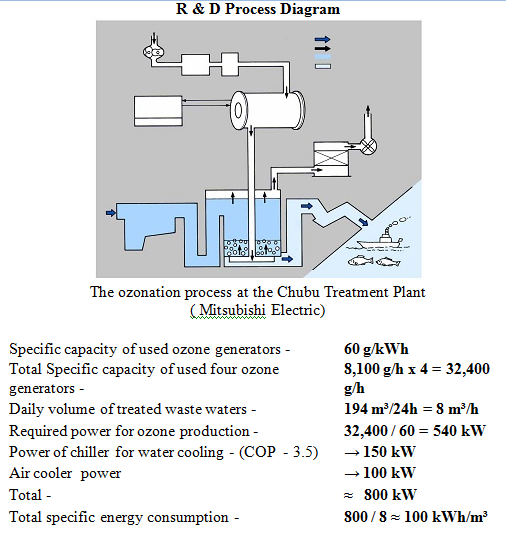
Ultra - Violet Light (UV)
The UV units for water treatment consist of a specialized low pressure mercury vapor lamp that produces ultraviolet radiation at 254 nm, or medium pressure UV lamps that produce a polychromatic output from 200 nm to visible and infra-red energy. The optimal wavelengths for disinfection are close to 260nm. Medium Pressure lamps are approximately 12% efficient, whilst Amalgam low pressure lamps can be up to 40% efficient. The UV lamp never contacts the water, it is either housed in a quartz glass sleeve inside the water chamber or mounted external to the water which flows through the transparent UV tube. It is mounted so that water can pass through a flow chamber, and UV rays are admitted and absorbed into the stream. In addition, it is required the installation of a 5 micron pre-filter before all UV disinfection equipment.
Minimal energy consumption during UV disinfection (assuming that the efficiency of combined-cycle coal-fired thermal power plants for electricity production - 33%, power distribution losses - 12%, the power of UV lamp - 100 W, the required duration of exposure - 60 sec., Guaranteed volume of wastewater during irradiation - 5kg) are:
(((100 W * 60sec)/5 kg water) /0.33)/(1 – 0.12) = 4,130 J/kg ≈ 1 kWh/m³ [4]
Comparing equations (3) and (4) suggests that the UV treatment, in terms of primary energy use, is on the order of thousands times more efficient than boiling over biomass.

Ultrasound (ultrasonic)
Main components of ultrasonic systems are:
- Transducers / Converters;
- Piezo-Electric Components;
- Booster elements;
- Custom Probes & Sonotrodes;
- Custom coupling assemblies;
- Assembled Baths and Chambers
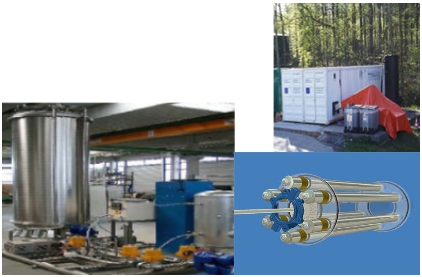
Radiofrequency Power
Radiofrequency (RF) power is a physical method of electromagnetic energy input that heats a product uniformly throughout its volume leaving no chemical residues. The process operates with electrical power that generates a rapidly oscillating electric field between 2 parallel electrodes (RF cavity) where the material to be processed is placed. Dipole and induced dipole molecules in the material continuously align and reorient themselves to the changing electric field, causing friction that converts to heat. In an overall 2-step process, electrical power is first converted to RF power, which is in turn converted into thermal power. Energy-use efficiency for the overall process depends on both power conversion steps.
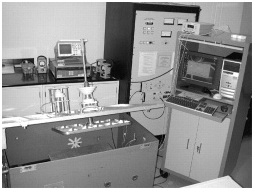
Electro-Hydraulic Effect (EHE)
Apparatus comprises a container having an inlet and an outlet, through which liquid to be disinfected flows in use; at least one pair of non-sacrificial electrodes. These electrodes being positioned in the container so that liquid flowing through the container is in contact with said electrodes; high voltage electrical capacitors and/or equipment for applying a steady-state electric voltage in the kilovolt range across said electrodes so as to create a voltage gradient between electrodes; the voltage gradient being such that an arc is not struck between electrodes but a voltage gradient of at least one volt is passed through the membrane of each cell, contained in liquid, that causes an electric breakdown of the cell membrane and hence results in destruction of the cell itself.
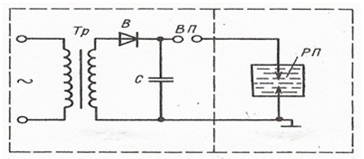
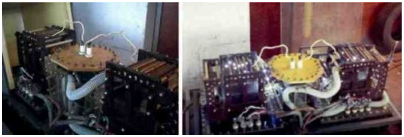
Shock waves are a major factor in bacterial decontamination with powerful pulsed electrical discharges in water. The idea of applying pulses of electrical discharge for the decontamination of water belongs to L.A. Yutkin. The achieved results in the 60-70 years of 20th century showed that experimental values of specific power decontamination by pulsed discharge was high enough (approximately 1÷10 kWh/m³ depending on the concentration of micro-organisms) that were not allowed to proceed to the practical work. Progress in pulsed power and the need for without chemical disinfectant methods of disinfecting water rekindled interest in the idea of L.A. Yutkin. A distinctive feature of pulse-periodic discharge with a pulse energy of (~ 1÷20J) - a local multi-effects on the microorganisms in a volume directly adjacent to the zone level of the specific energy of ( 0.5÷1.0) kWh/m³. In the case of a powerful pulsed discharge (pulse energy of several kJ) main factor effects on the microorganisms becomes the shock wave. The destruction of microorganisms is possible with single exposure level in contrast to the pulse-periodic discharges of low power when the effect of decontamination is achieved by the “accumulation of damage” in microorganisms. If you are using a powerful discharge substantially increases the thermal and mechanical stress on the elements of the system design, but you can reduce the specific power needs by reducing the number of discharging to one and increase the volume of water disinfectant.
A possible mechanism of destruction of microorganisms from the effects of shock waves - is damage to cells and structures due to thermal and mechanical effects.
When a powerful pulsed discharge in water, the shock wave is born and formed in the vicinity of the discharge axis at a distance of 3-5 mm away from the axis (energy density of 3 kJ/cm²). When a differential pressure of 50 MPa, the thickness of the front is much less than the characteristic size of microorganisms (approximately 1 ÷ 10 micrometer) that allows us to consider the past as a macro-facility. The most probable mechanism of destruction of microorganisms - the fragmentation of the development owing to the volatility in the flow. This value (50 MPa) may serve as a model for the practical realization of the conditions of destruction of microorganisms in the single exposure level.
Light-Hydraulic Effect (LHE)
In generally, apparatus comprises a chamber – “light hydraulic crusher” or “disintegrator”, a closed volume of which is filled with sewage water wherein the light impulse from the laser source is focused with a help of a lenses system. Two hydro-seals of a coil type, create a continuous liquid flow. Besides, they are intended to suppress the shock wave and eliminate the pressure difference and shocks between the chamber and the reservoirs with sewage and disinfected water. It is known that dissolved gases or those formed in the liquid can be released there, thus damping the LH-shocks and reducing the effectiveness of the shock wave action in the chamber during the discharges. A receiver connected to the chamber cavity via a brake channel is positioned in the upper position of the chamber for continuous withdrawal of said gases. Brake channel bends also fully suppress the shock damping in said chamber. The drain cock of the receiver allows to discharge periodically the accumulating gas to the outside.
